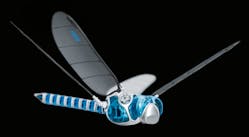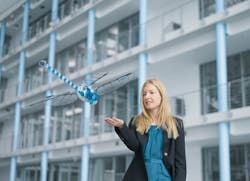A small and ultralight UAV developed by engineers at Festo, Esslingen, Germany, reportedly can match the highly complex flight capabilities of a dragonfly. Called the BionicOpter, the robotic insect can fly in any direction — even backwards — turn and accelerate quickly, hover, and glide without beating its wings. It’s said to be the first aircraft that flies like a helicopter, plane, and glider.
A motor in the bottom of the housing drives the four wings at a common beat frequency, which is adjustable between 15 and 20 Hz. Like a real dragonfly, the
BionicOpter’s wings can turn from horizontal to vertical. For this, servomotors individually twist each wing up to 90°.
Four motors at the wing joints control flapping amplitudes. Linear movement in the wing root adjusts a crank mechanism to vary the deflection between approximately 80° and 130°.
Movements by the head and tail provide fine control. The dragonfly body is fitted with four flexible "muscles" made of Nitinol — a shape-memory alloy (SMA) that contracts when heated and expands when cooled. Passing an electric current through the SMAs creates ultralight actuators that move the head horizontally and the tail vertically.
To correct for any vibrations and ensure stable flight, data on position and wing twist are continuously evaluated in real time as the dragonfly flies. Inertia sensors measure the acceleration and tilting angle of the BionicOpter in space, while position and acceleration sensors detect speed and spatial direction.
Despite its complexity, the aircraft is controlled with a smartphone or digital transmitter. The pilot inputs direction and speed, and an onboard microcontroller calculates operating requirements based on recorded flight data and sends commands to servomotors and actuators.
The BionicOpter was developed by Festo’s Bionic Learning Network. Together with researchers at universities and development firms, the Network supports projects and develops test models whose basic technical principles — like energy efficiency and lightweight construction — are derived from nature. Among other recent developments: a SmartBird which models bird flight, robot arms much like an elephant trunk, and adaptable grippers based on a fish’s tail.
These strategies, say Festo officials, can be applied to engineering problems in the industrial world. For example, the remote-controlled dragonfly demonstrates wireless real-time communication, a continuous exchange of information, as well as the ability to evaluate multiple sensor inputs and identify complex events and critical states. For Festo, the principle of continuous diagnostics helps ensure operational reliability and process stability — whether in bionic flying objects or everyday industrial machines.
Likewise, industrial networks figure large in production systems of the future. Centralized plant control will give way to greater use of decentralized operations. Tasks that are currently performed by a master computer will increasingly be done by remote components. Festo believes this digital refinement will give rise to increasingly intelligent subsystems that can actively support production processes, thanks to capabilities like energy autonomy and condition monitoring — in the smallest of installation spaces. Festo says the BionicOpter illustrates such integrated functions and miniaturization.
Resources: Festo, www.festo.com/us
See video of the BionicOpter at: www.youtube.com/watch?v=nj1yhz5io20


